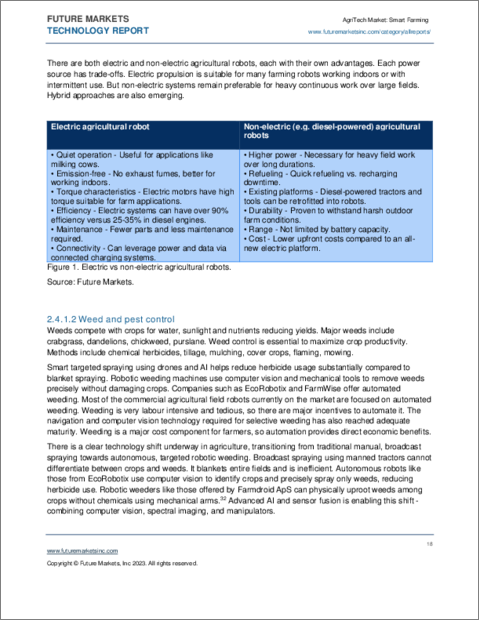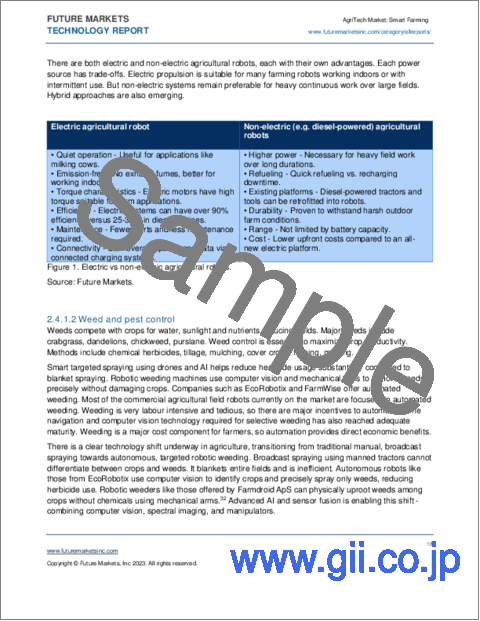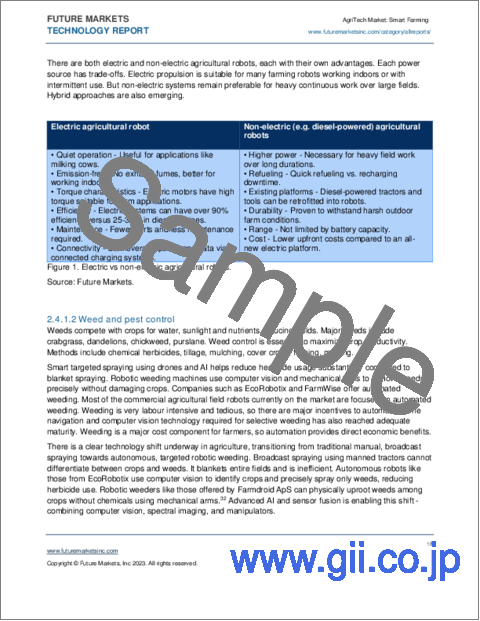|
|
市場調査レポート
商品コード
1376524
スマート農業の世界市場:2024-2034年The Global Market for Smart Farming 2024-2034 |
||||||
|
|||||||
| スマート農業の世界市場:2024-2034年 |
|
出版日: 2023年11月08日
発行: Future Markets, Inc.
ページ情報: 英文 184 Pages, 18 Tables, 40 Figures
納期: 即納可能
|
全表示
- 概要
- 図表
- 目次
当レポートでは、世界のスマート農業の市場を調査し、市場概要、市場成長への影響因子および市場機会の分析、主なスマート農業技術の詳細分析、市場規模の推移・予測、技術・地域別の内訳、競合情勢、主要企業のプロファイルなどをまとめています。
目次
第1章 調査手法
第2章 スマート農業
- 市場概要
- 市場促進要因
- 市場の課題
- 技術
- アグリボットと自律型トラクター
- 作物のモニタリングとアナリティクス
- 精密畜産・モニタリング・アナリティクス
- ドローンと人工衛星
- 資金調達と投資
- マーケットマップ
- SWOT分析
- 世界市場の収益予測
- 技術別
- 地域別
第3章 企業プロファイル(192社)
第4章 参考資料
List of Tables
- Table 1. Market drivers in smart farming
- Table 2. Market challenges for smart farming
- Table 3. Current uses of agricultural robots
- Table 4. Potential future uses and applications of agricultural robots
- Table 5. Autonomous sensor technologies in smart farming
- Table 6. Weed and pest control agribots
- Table 7. Other autonomous farming machines and robots
- Table 8. Other autonomous farming machines and robots products
- Table 9. Advantages and Disadvantages of Robotic Milking
- Table 10. Key companies in robotic milking
- Table 11. Market readiness of various technologies in the smart farming crops monitoring and analytics sector
- Table 12. Key players in crops monitoring and analytics
- Table 13. Commercially available agricultural drones
- Table 14. Drones vs. satellites vs. aeroplane
- Table 15. Commercially available spraying drones
- Table 16. Funding and investments for smart farming
- Table 17. Global market revenues for smart farming 2018 to 2034, by technology, billions USD
- Table 18. Global market revenues for smart farming 2018 to 2035, by region, billions USD
List of Figures
- Figure 1. Electric vs non-electric agricultural robots
- Figure 2. Bug Vacuum by Agrobot
- Figure 3. Anatis by Carré
- Figure 4. Avo by ecoRobotix
- Figure 5. GEN-2 by Ekobot
- Figure 6. Arbus 4000 JAV by Jacto
- Figure 7. AX-1 by Kilter
- Figure 8. Oz by Naïo Technologies
- Figure 9. Dino by Naïo Technologies
- Figure 10. Weed Whacker by Odd.Bot
- Figure 11. Robot One by Pixelfarming Robotics
- Figure 12. Titan FT-35 by Roush and FarmWise
- Figure 13. Dick by Small Robot Company
- Figure 14. Autonomous weeding robots by Vitirover
- Figure 15. FD20 by FarmDroid
- Figure 16. Genesis by FarmBot
- Figure 17. eTrac unmanned electric tractor by Farmertronics
- Figure 18. EOX-175 by H2Trac
- Figure 19. Monarch Tractor
- Figure 20. AgBot by AgXeed
- Figure 21. Robotti 150D by Agrointelli
- Figure 22. RoamIO (Korechi)
- Figure 23. Land Care Robot by Directed Machines
- Figure 24. Ted by Naïo Technologies
- Figure 25. PothaFacile by Pietro Rivi
- Figure 26. SwarmBot 5 by SwarmFarm Robotics
- Figure 27. Dot by Raven Industries
- Figure 28. Trektor by SITIA
- Figure 29. Bakus by VitiBot
- Figure 30. FFRobot apple harvester
- Figure 31. Harvester B7
- Figure 32. CropHopper by HayBeeSee
- Figure 33. Market map for smart farming
- Figure 34. SWOT analysis: Smart Farming
- Figure 35. Global market revenues for smart farming 2018 to 2034, by technology, billions USD
- Figure 36. Global market revenues for smart farming 2018 to 2035, by region, billions USD
- Figure 37. Crover Robot for Grain Storage Monitoring
- Figure 38. FFRobot collector
- Figure 39. GR-100 by Four Growers
Smart farming leverages advanced technologies like sensors, robotics, AI, and IoT to optimize agricultural operations, boost productivity, and reduce environmental impact.
Key technologies include:
- Agribots and autonomous farm equipment including self-driving tractors and robotic harvesters
- Sensors and computer vision for precision crop monitoring
- Livestock monitoring and analytics with wearables and computer vision
- Drones and satellites for field mapping, crop spraying, and data analytics
- AI and advanced analytics software for predictive insights
“The Global Market for Smart Farming 2024-2034” provides a comprehensive analysis of the key technologies, companies, and market trends shaping the future of agriculture. The report covers major smart farming segments including agribots, autonomous tractors, crop monitoring analytics, livestock monitoring, drones and satellites. It analyzes the benefits, applications and readiness of innovative technologies like computer vision, AI, proximal sensors, robotics and IoT in farming. The competitive landscape, SWOT analysis and global smart farming revenues to 2034 are presented.
Regional markets analysed include: North America, Europe, Asia Pacific, Latin America, Middle East and Africa. Crop specific applications in robotic harvesting, dairy farming, precision spraying, livestock monitoring and greenhouse automation are evaluated. The report provides actionable intelligence for agriculturists, technology vendors, investors and policy makers on the transformative technologies that are driving efficiency, sustainability and productivity in the future of smart agriculture globally.
Report contents include:
- Market overview and drivers of smart farming adoption
- Challenges inhibiting technology adoption in agriculture
- In-depth analysis of major smart farming technologies:
- Agribots and autonomous tractors
- Robotic harvesting, weeding, pest control
- Self-driving tractors
- Livestock monitoring with AI and sensors
- Satellite, aerial imagery
- Drones for spraying, analytics
- Precision agriculture software and analytics
- Profiles of over 210 leading smart farming companies. Companies profiled include AgriWebb, Agtonomy, BeeHero, Bonsai Robotics, Bushel, Carbon Robotics, CNH Industrial, Croptix, CropX, Ecorobotix, FarmSense, Fieldwork Robotics, Guardian Agriculture, GroGuru, John Deere, Koidra, N-Drip, Pastoral, Picketa Systems, Pollen Systems, Sabanto, Sentera, and StrongBó Agritech.
- Competitive landscape analysis of vendors
- Global smart farming market revenues 2018-2034
- Regional breakdown of market revenues
- SWOT analysis of smart farming industry
- Key insights on technology readiness and applications
- Impacts for farmers, technology vendors, investors
TABLE OF CONTENTS
1. RESEARCH METHODOLOGY
2. SMART FARMING
- 2.1. Market overview
- 2.2. Market drivers
- 2.3. Market challenges
- 2.4. Technologies
- 2.4.1. Agribots and autonomous tractors
- 2.4.1.1. Autonomous sensor technologies
- 2.4.1.2. Weed and pest control
- 2.4.1.3. Robotic seeding
- 2.4.1.4. Fully autonomous tractors
- 2.4.1.5. Other autonomous farming machines and robots
- 2.4.1.6. Robotic fruit and vegetable harvesting
- 2.4.1.7. Dairy farming robots
- 2.4.2. Crops monitoring & analytics
- 2.4.2.1. Satellite/aerial imagery
- 2.4.2.2. Proximal sensors
- 2.4.2.3. Software analytics
- 2.4.2.4. AI-based analytics
- 2.4.3. Precision livestock farming, monitoring & analytics
- 2.4.3.1. Smart wearable tags and collars
- 2.4.3.2. Computer vision systems
- 2.4.3.3. Autonomous mobile robots
- 2.4.3.4. Wireless sensor networks
- 2.4.4. Drones and satellites
- 2.4.1. Agribots and autonomous tractors
- 2.5. Funding and investments
- 2.6. Market map
- 2.7. SWOT analysis
- 2.8. Global market revenues to 2034
- 2.8.1. By technology
- 2.8.2. By region






